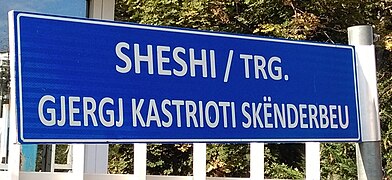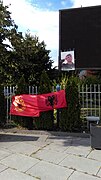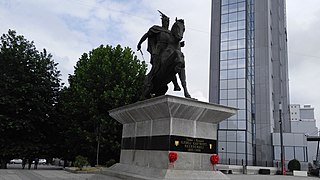Skanderbeg Square, Pristina
Skanderbeg Square Sheshi Skënderbeu | |
|---|---|
| Public square | |
 Skanderbeg's statue in the square | |
| Owner | Pristina Municipality |
| Coordinates: 42°39′49″N 21°09′50″E / 42.6636°N 21.1638°ECoordinates: 42°39′49″N 21°09′50″E / 42.6636°N 21.1638°E | |
Skanderbeg Square (Albanian: Sheshi "Skënderbeu") is a square in Pristina, Kosovo.
Location and history[]
Following the end of the Kosovo conflict in 1999 and longer under Serbian rule, Kosovo Albanians in 2001 erected a monument within the centre of Pristina to Skanderbeg, a medieval Albanian who fought against Ottoman forces.[1][2] Over a journey of four days the statue was brought from Krujë in Albania to the middle of Pristina.[3] The Skanderbeg statue of Pristina shares a similar socialist aesthetic and equestrian posture with minor differences in detail to existing Skanderbeg monuments in Tiranë, Skopje and other places in Europe.[3] Skanderbeg is depicted on a horse with its right leg up in a menacing pose and his sword is outside of its sheath and pointed toward the ground.[3][4][2] A war memorial dedicated to the victims of the Kosovo war is present in Skanderbeg square along with a series of photographs depicting the missing from the conflict.[5] Skanderbeg Square is bordered on one side by Rugova Square, a space named after the first Kosovo President Ibrahim Rugova and on the other side by Mother Teresa Boulevard, named after Saint Teresa of Calcutta.[2] Along with Tiranë and Skopje, Pristina is one of three Balkan capitals to install a Skanderbeg statue.[6]
Gallery[]

Bilingual sign designating Skanderbeg Square

Skanderbeg statue

Skanderbeg Square
Parade by Kosovo Security Force in square

War memorial dedicated to the victims of the Kosovo war

Banner with photographs depicting the missing from the conflict

Banner and flags honouring the Kosovo Liberation Army

Banner with photographs depicting the missing from the conflict

Poster of Skanderbeg in square

Pedestal plaque of the Skanderbeg statue

Skanderbeg statue on old pedestal (2000s)

Skanderbeg statue on new pedestal (2010s)
See also[]
- Skanderbeg Square in Tiranë, Albania
- Skanderbeg Square in Skopje, North Macedonia
References[]
- ^ Ragaru 2008, pp. 531, 549-550.
- ^ a b c Björkdahl & Kappler 2017, pp. 57-58.
- ^ a b c Ragaru 2008, pp. 550.
- ^ Di Lellio, Anna; Schwanders-Sievers, Stephanie (2006). "The Legendary Commander: The construction of an Albanian master‐narrative in post‐war Kosovo" (PDF). Nations and Nationalism. 12 (3): 17.
- ^ Björkdahl, Annika; Kappler, Stefanie (2017). Peacebuilding and spatial transformation: Peace, space and place. Routledge. p. 57. ISBN 9781317409427.
- ^ Ragaru, Nadege (2008). "The Political Uses and Social Lives of "National Heroes": Controversies over Skanderbeg's Statue in Skopje". Südosteuropa. 56 (4): 549–550.
External links[]
 Media related to Skanderbeg Square (Pristina) at Wikimedia Commons
Media related to Skanderbeg Square (Pristina) at Wikimedia Commons
- Geography of Pristina
- Tourist attractions in Pristina
- Squares in Kosovo











